Summer North AGS Show, 2012
The first Summer Show North I attended was held in a Methodist church hall on the outskirts of Huddersfield some 30 years ago; since then it has migrated to Headingley (a suburb of Leeds), Pudsey, back to Headingley, back to Pudsey, and now, after a couple of intermittent fallow years, east to Pontefract, famed for its race course (the local hotel has a helipad to accommodate peripatetic jockeys) and its Pontefract cakes (soft liquorice lozenge sweets, handed out liberally on the day, but an acquired taste: I wasn’t feeling in the least hungry).
This latest hall is of good size, well-illuminated, and easily reached (though the signage for those travelling westwards is tricky; most of the directions are only visible when travelling from the opposite direction). The day’s proceedings were conducted by Director of Shows Ray Drew, still hoarse from cheering on the England football team in the Euro championships the night before.
All the way up to Pontefract one witnessed Union Jack flags, pennants and bunting at every turn – draped from upstairs windows; as banners or criss-crossed row upon row above narrow streets; fluttering from car boots and bonnets; even festooning a mobility scooter that ripped along at an astonishing rate, a short distance the showhall. While some of these referenced the football match, the majority bore testimony to the Diamond Jubilee, which had culminated less than a fortnight beforehand in an especially pluvial Pageant along the Thames.
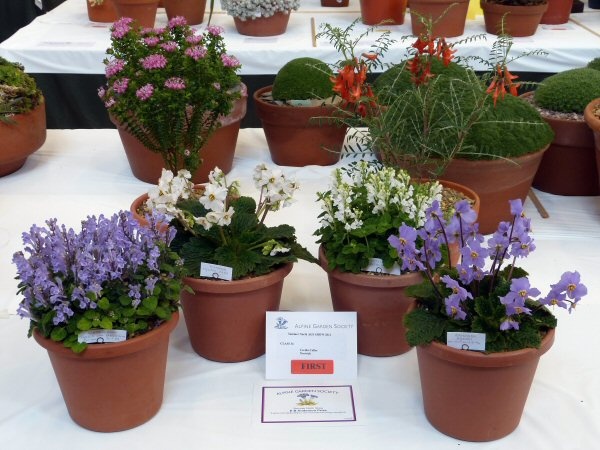
I mention this because Cecilia Coller, the reigning queen of the show bench (and a staunch admirer of the country’s official monarch) put together a patriotically Jubilee-themed, red (erm, pink in part, but never mind), white and blue assemblage involving Ramonda myconi in pure white and mauve-blue forms, Scutellaria indica var. parvifolia in analagous colour separations, Pimelia ferruginea and Sutherlandia montana.
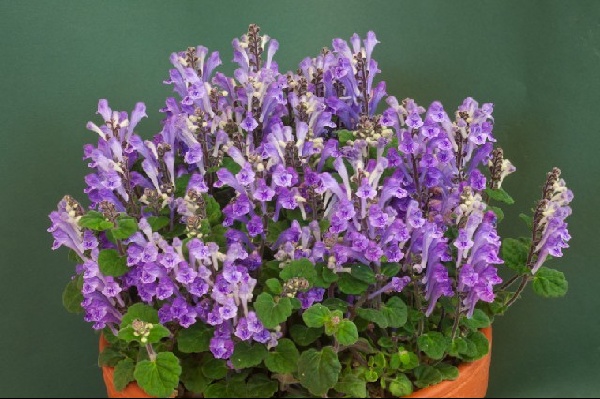
A particular pleasure to see again the last-named, hardiest of an exclusively African genus that extends from Namibia across to Botswana, south to the Cape and the Drakensberg. A subshrub of up to 60cm, but in some forms confining itself to half that height, from the upper half of its tomentose shoots, heads of showy scarlet pea flowers to around 5cm long are carried bolt upright. Jack Elliott, a fondly-remembered past AGS president, grew it especially well in his Kentish garden from a 1987 collection made at Naude’s Nek in the Eastern Cape at 2,250m (CDRX 131) – probably the same source as the plant shown. It has been recorded from Kwazulu-Natal, Lesotho and adjacent areas south to Barkly East (Eastern Cape), growing in veld between grass tussocks on dry slopes, or among rock outcrops, at 1,400-2,450 (3,000) m. The attractive, inflated seedpods are also noteworthy.
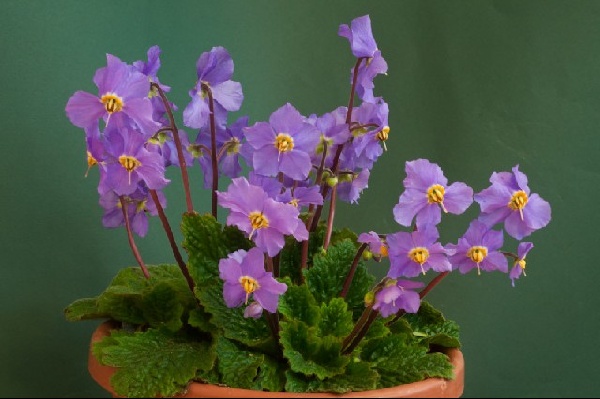
Cecilia won not just this (and the E.B. Anderson Prize in the process) but both the other two small six-pan classes, and easily picked up the Ridings Salver for most first prize points in the Open Section. Her plants of Ramonda myconi, all from an August 1994 sowing (i.e. sown fresh: they germinate within a few weeks but initial progress is decidedly slow), and at their best a month later than the main crop (though my 1983 diary entry records a pale pink version, the seed obtained by Inshriach Nursery, was in its prime on that occasion), were deployed in various classes, all grown in part shade so that their foliage was immaculate.
One was shown successfully in the large three-pan class, along with Roscoea humeana ‘Inkling’ and a 40cm tall, billowing Nierembergia pulchella (JJA.2.655.500, from seed collected at 4,000m in Catamara Province by John & Anita Watson), a NW Argentina endemic that produces a mass of whitish, bluish-centred, crumple-petalled flowers in early to mid-summer. One of several exciting species from this under-explored area of the Andes (another is even larger-flowered, and pure yellow), it roots easily from unripe cuttings, flowers in its second year from seed, but can be crucified by a hard winter, despite its provenance.
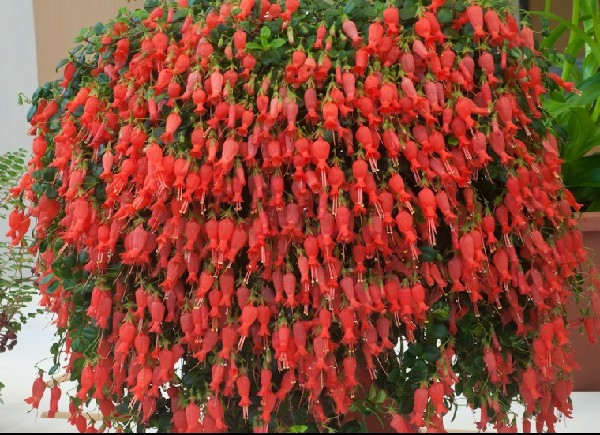
Notwithstanding the stop-start occurrences of this event in recent years, the show was well supported, and well attended too. But the drenching weather preceding the meet (view the already mentioned Royal Pageant footage to get some idea of the prevailing conditions) had done very little to bolster the efforts of exhibitors countrywide, so that although several plants were considered for the Farrer Medal, a compromise best in show accolade was the preferred verdict.
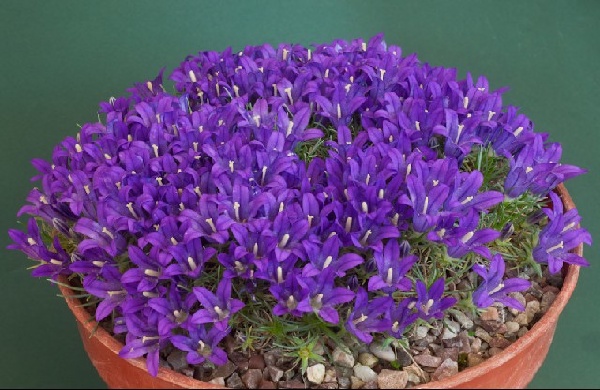
There was a (from one side) magnificent Sarmienta repens (Jim & Wilma Wright - above), yet if scrutinized from the top decidedly tonsured, and not quite so exuberantly flowered if viewed from the back. George Young had a very likeable Edraianthus dinaricus [right], sown in November 2008 and almost covered with deep violet-blue flowers: my victor ludorum, though only three other hands went up in support.
_-_Barry_Winter22111.jpg)
A third contender, Barry Winter’s 50cm across, bravura Verbascum ‘Letitia’ [below], was both mature and well-flowered, but just slightly past its peak flowering, so that although every single withered flower had been meticulously picked off, the judges looked at the vacated calyces lower down the abundant flush of flowering stems, commiserated, but felt that the Farrer Medal should be withheld.
It is rumoured that post-match comment has railed against the pernickety exactitude of the judging panel. As a member of this contingent, I wish to record that those assembled would have been truly delighted to have seen a plant fully deserving of the accolade, that none doubted the best voted plant in show would have been an automatic choice a few days beforehand (and possibly a few days afterwards), but that some shows are denied such a candidate, yet others can have a dozen or more: it all depends on who turns up, and the weather.
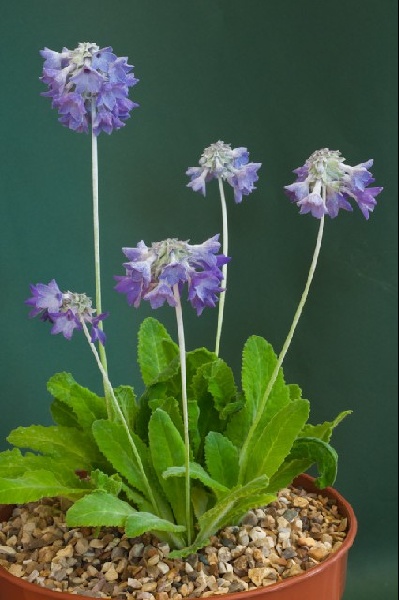
A further 1983 flashback: in that year three Soldanelloides Section members of Primula were exhibited (P. cawdoriana, P. reidii var williamsii and P. flaccida, which at that time was still going the rounds under the name P. nutans). In 2012 only the last of these was shown, though to very good effect, for Pamela Anderson’s five-stemmed entry – obtained only a couple of years previously from Edrom Nurseries – won the Charles Graham Trophy for the best plant in the Intermediate Section. A Chinese representative of this most distinguished coterie within the genus, all of them beautifully scented, it is often monocarpic, but sets a generous amount of seed to mark its passing and ensure its perpetuation. What a pity that it isn’t more often exhibited.
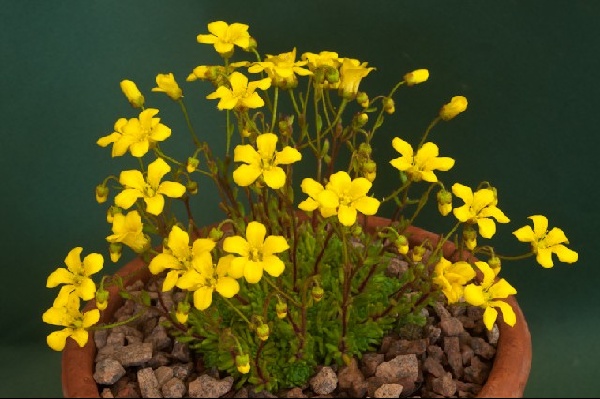
Of much more recent introduction, Saxifraga llonakhensis (from the often autumnal Section Ciliates, subsection Rosulares) was described a century ago, from Sikkim, though occurrences in Nepal to the west and eastwards through to Tibet, Burma and Yunnan have since been confirmed. The slightly furry rosettes are attractive in themselves, and when crested with a display of bright yellow flowers on wiry pedicels, an encouragement to obtain material of this presently offered species. Peter Hood staged the best of the several plants on display, which had been grown in a mix of 40% John Innes no. 2 and 60% grit that was kept perpetually moist from spring onwards.
There were quite a few ‘silver’ (Ligulatae) saxifrages to admire, not all of them as abundantly-flowered as might have been hoped, given the timing of the show. But Saxifraga Southside Seedling’ Group, derivatives of a fortuitous Surrey seedling of S. cotyledon now one year past its diamond jubilee, is one of the most striking of them all, and two exhibitors brought along mighty single plumes (these can easily snap if bumped and jolted for any distance: cotton wool cladding is recommended for their transport).
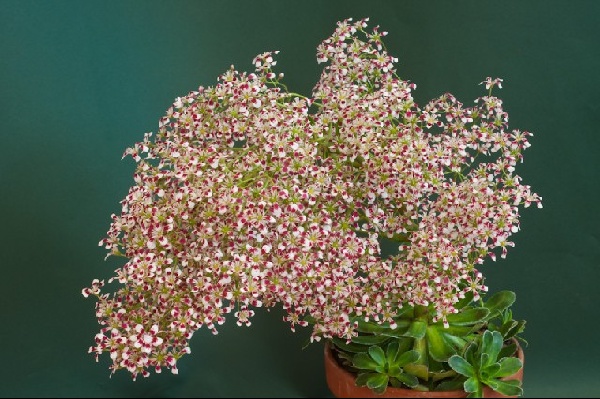
Norman Davies had coaxed a splendid spike to its apogee, identified as S. ‘Ruby Southside’ on account of its heavily crimson-spattered constituent flowers. Both plants seen had a promising number of side rosettes, which are best detached and grown on separately to perpetuate selected vibrant forms: raising seedlings is also well worthwhile, and gives far more offspring.
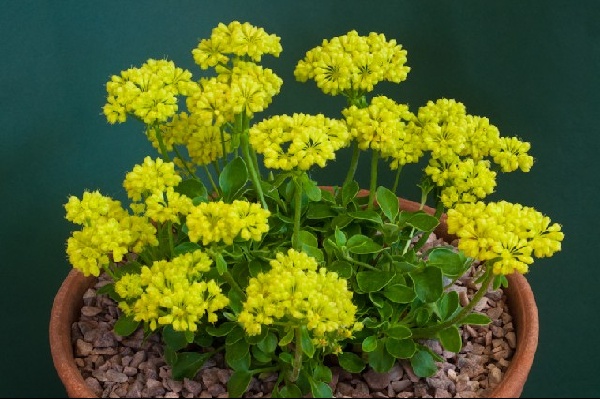
North American plants were on duty in force, from a handsome group of Calochortus albus var. rubellus (Fred & Pat Bundy) – eight resplendent stems with no sticks or twining to support these – to Anne Vale’s creamy, mint-scented cascade of Monardella nana var. tenuifolia. Eriogonums too: Trevor Whitaker won a heavily-contested class with his dwarf, gleaming chrome-yellow E. umbellatum var. haussknechtii, from a Mt Hood (Oregon) collection made four years previously. (This is from Hood River County, at 2,100m (6,800’), which Ron Ratko listed as growing ‘at tree-line and above on glacial screes ... Perianths are darker yellow developing red markings soon after opening’.) From the opposite, eastern side of the country, there was a seven-flowered clump of Cypripedium kentuckiense (British dactylorhizas, in comparison, were not at their finest, though John Richards took a morning detour to the nearest pond and found excellent examples in full bloom).
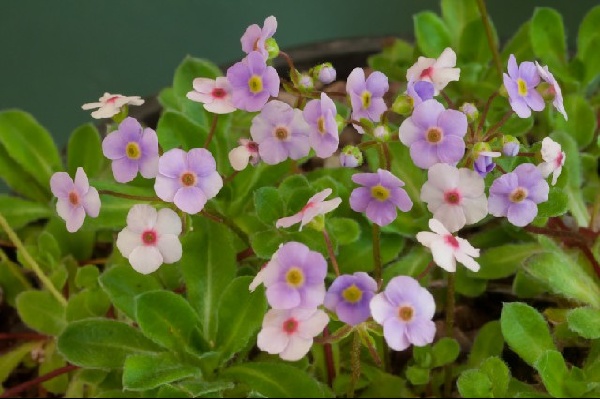
Heading east again, Lionel Clarkson’s Androsace aff. hookeriana, with flowers in white, pale lilac and mauve-pink, depending upon their age, was an alluring, high alpine analogue of the biennial Viola tricolor ‘Yesterday, Today and Tomorrow’. The species-complex occurs from eastern Nepal through to Assam, and further introductions are adding to its mutability. Ron McBeath’s celebrated 1987, CLD introductions of Roscoea humeana forma alba were twice shown (Pat & Fred Bundy); immaculate from afar but slightly pock-marked by incessant bouts of torrential rain when inspected closely.
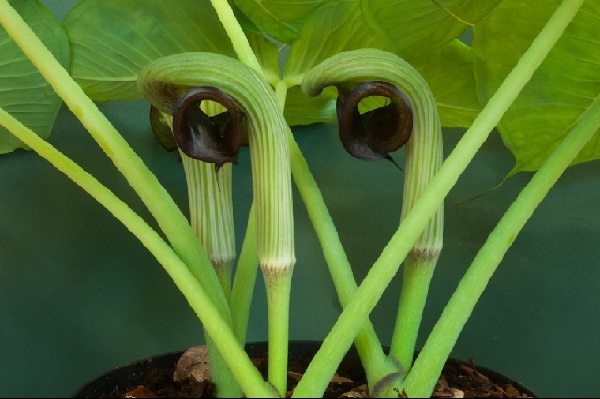
Best of all – and this despite my antipathy when it comes to the excessively leafy or sombre members of its customarily sinister rather than seductive and seemly components − Ivor Betteridge’s Arisaema ringens (Chinese in part, but also from Taiwan, Korea and Japan, predominantly at low elevations) won its class against stiff opposition, gleaming in the muted, fitful sunlight of an otherwise dampish day.
With any luck the show has now come to rest in this almost purpose-built venue: with any luck the weather in future years will be kinder to exhibitors and their plants!
